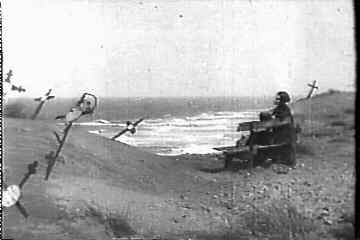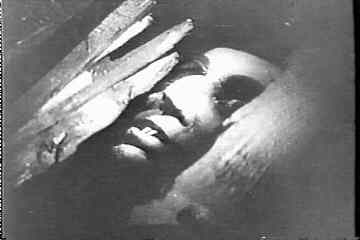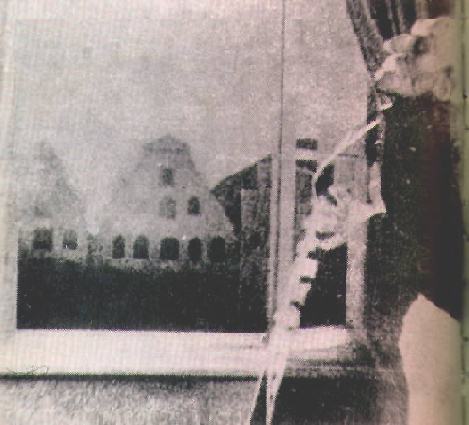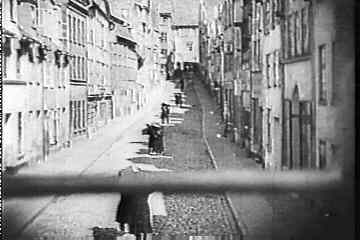


From a very early age I recall seeing the picture of actor Max Schreck in his hideous makeup as Count Orlock in the film books I checked out of the small library in Powell, Wyoming. I could only imagine the kind of shadows and tectures that made up the film that these photographs came from, for I did not see it until nearly ten years after my fascination with these images began.
I was a teenager when I received in the mail a package from Griggs Moviedrome, a New Jersey company that specialized in 8mm prints of silent films for collectors. Inside the box was an uninspiring white package that held four reels of Standard 8mm film, the four reels of a print of Murnau's Nosferatu. To this day when I put those reels on my projector I am taken into some kind of strange dream state.
My print of Nosferatu has some steady scratches put onto it by one projector on its last legs and the first two reels are a little soft, but this 8mm print still holds great power. Though I hope someday to see a sharp 35mm print of the film, to me part of the sway that this film has over me will always come from the low definition 8mm picture of my own print thrown up many times its size on a wall.
Nosferatu is the story of Dracula, of a vampire moving from his secluded castle to real estate he has purchased in the city of Bremen, where he will find a constant source of victims. Although the vampire is a creature of the night, Murnau has made his film in daylight. He has left the studio and the set to make his vampire story in mountains and in the sun-drenched streets of a fantasy city. Murnau's vampire stands with curling fingernails under a clear sky on the deck of a boat, whose rigging curls like Orlock's nails.
Murnau's Dracula story is peopled with characters with names
different from Stoker's Dracula, but in the print I own the names
have been returned to Stoker's. In Murnau's the Count was named Orlock and Renfield was called Knock, but I will refer to the characters with the names they are given in my print.

Nosferatu is a film about simultaneity, about characters in isolation reacting to other characters far away from them. The most noted instance of this is the sequence in which Mina sleepwalks as the Count attacks her husband far away in his castle. She screams out to Jonathan but the Count hears her call, and leaves Jonathan alone to begin his journey to Bremen. This is the most noted example, but from this point on the film is a series of such cutting. There is the Count's journey by raft and then by boat intercut with Jonathan's recuperation and trip by horse. These two acts are intercut with the Professor's lecture about carnivorous insects and Mina's wait for Jonathan. She sits on the dunes of a beach in the middle of crosses at odd angles. She sits in the cemetery planted in the shifting sands at the edge of the sea. And later still, Mina is intercut with the Count and Renfield with the Count as well.
Nosferatu is a series of shots of single characters acting in isolation, but in concert with others. The power of film editing, of placing one image beside another, brings them all together.
The story has all the familiar elements of the classic Dracula stories, like Jonathan's journey to the castle in Transylvania. In Murnau's film, Jonathan travels through nature, past rugged mountains with bits of rocks scattered all about.

Max Schreck is a thing derived from yet completely removed from nature. His count has a rat face and he moves around in fast scurrying movements, thanks to stop motion photography. He can rise out of his coffin as flat and fast as a board on a catapult. He fills the darkness in a doorway like no vampire that ever followed him could.
Nature has a major part in the film. Oddly shaped mountains follow Jonathan's progress to Orlock's castle. One rock formation looks like a chimney and the Count's castle tops a mountain as if it was eroded out of the mountain rather than built atop it.
One of the film's most disturbing elements is the rats that follow Orlock, that live in his coffins, that scatter when he leaves the ship, these clusters of rats that live in the dirt of coffins. But there are other disturbing images and elements, disturbing and silent. The procession of men carrying the coffins of their city's dead through the valley-like street of the film's Bremen -- their procession is broken horizontally by the sash of the window from which Nina is watching. The ship, the Demeter, its crew now dead, moving smoothly on a bay still as glass. There is something so strong about that ship that tells us that it is being steered by no one alive but by a captain killed and roped tight to his wheel.
The film is wordy for a silent film, full of journal entries, letters, and passages from books but the overabundance of words only seems to add to the mystery of the film, to the work of mystery that the viewer must take to this film.

Nosferatu is a film that has grown on me over the years. It is a film regarded highly by connoisseurs of vampire films, but I used to think it far inferior to The Last Laugh or Sunrise. Although it may not have the polish of those later films it does possess a foggy darkness despite its sun-drenched images. Its frank gruesome quality is a stark contrast to the scratchy clean horror of Universal's horror films of the 30's and 40's, and the completely unromantic treatment of the Count fits well with modern cynicism. Max Shreck's Orlock is one of the most familiar images in film history, or for that matter in the history of images.
 Cast (in alphabetical order)
Cast (in alphabetical order)NosferatuMovie.com is a wonderful site about the movie, put together by Silent Orchestra, which has written a score for the film.
Here is a song about Nosferatu!
Nosferatu on the Internet Movie Database.
Watch Nosferatu on line via RealVideo at The Sync Video on Demand.
If you need a Nosferatu mask, you will find one here
Back to Sloppy Films
Copyright © 2000 John Akre
http://www.sloppyfilms.com/murnau/nosferat.htm